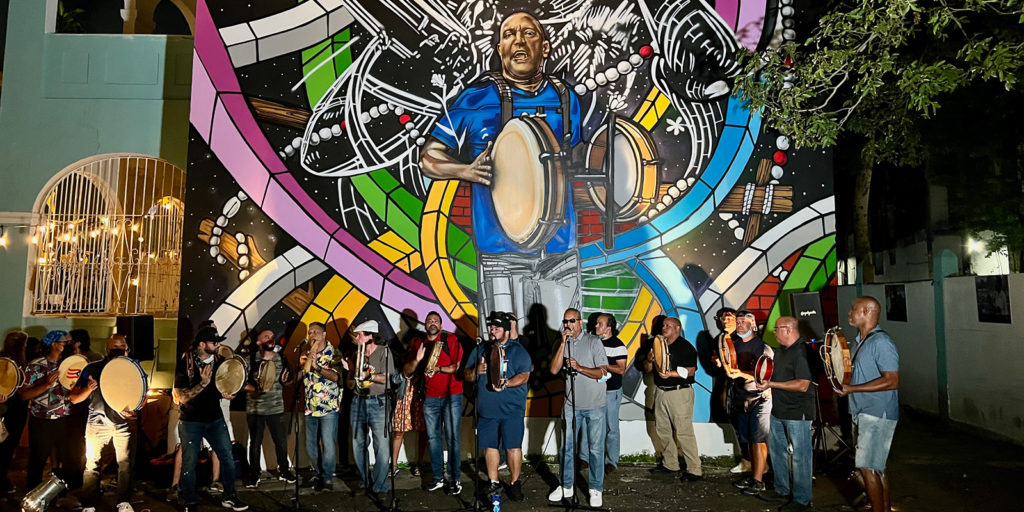At a time when social media is replacing traditional cultures, La Casa de la Plena Tito Matos is keeping Puerto Rican traditions alive by training the next generation of Pleneros.
La Plena
La Plena is a Puerto Rican musical tradition with roots in the African Diaspora. It’s a song, drum and dance tradition that is performed on the streets in Puerto Rican communities.
It uses three sizes of hand drums that don’t sound like much alone, but together create a symphony of percussion. Some groups add horns or guitars. Lyrics follow a four-line pattern that is sung by the lead singer and then mirrored by the community in a powerful call-and-response. As the song progresses, the lead singer improvises new verses.
“Tintorera del mar
Tintorera del mar
Tintorera del mar
Que sea comido Americano”
This old Plena basically says that the female Blue Shark in the sea, ate the American. Our improvised verse was “Soy comida del mar…pa’que yo soy Americano” (I’m food of the sea, because I am American.) LOL.
Plena is often called “the sung newspaper” because it was an important way to spread the news in the days before radio, television, internet and mobile phones. Songs can be news, they can be flirty, or they can be just making fun of ourselves and each other.
The tradition is also a means of political expression. Puerto Ricans are not shy about expressing our points of view. When young islanders began protesting against Governor Ricky Rosselló, we knew he was finished when the Pleneros started singing against him, because Plena is the voice of the people.
It’s often said that Plena originated in Ponce in Southern Puerto Rico, but the pandereta drum comes from West Asia. It’s an Arab drum that came to Puerto Rico via Mother Africa in colonial times. Like all Latin Music, Plena was suppressed in the beginning, but today it is a beloved marker of Puerto Rican identity.
The street-singing tradition is derived from West African Griot and European troubadour traditions. In The Bronx, New York, Plena is one of the precedents of Rap and Hip-Hop.
Life in Puerto Rico is centered around eating, drinking, singing and dancing outdoors with family and friends. There is even a word for it, “chinchorreo,” and several routes where you can go from one chinchorro (beach shack or roadside bar) to the next until you can’t stand up. We sing a lot of Plenas at family gatherings and chinchorros. Everybody knows the traditional songs. If you get into La Plena, you will never be alone and the love in your life will grow exponentially.
Tito Matos
Tito Matos (1968-2022) was one of Puerto Rico’s top Plena virtuosos, and an important teacher and guardian of our cultural traditions.
Born in Rio Piedras, Tito set up Plena schools there and at La Goyco, a community center in Santurce. Tito’s love for la Plena began when his abuelo gave him a pandereta for Three Kings Day when he was eight years old. He was raised in Villa Palmeras which is one of Puerto Rico’s centers of traditional Bomba, Plena and Salsa culture.
Tito moved to New York City in 1994 and joined Los Pleneros de la 21, one of NYC’s leading Bomba and Plena groups. In 1996, he became part of Viento de Agua, a group that made contemporary fusions based on Bomba, Plena and some Cuban traditions. He later founded La Máquina Insular which was a return to Plena roots.
Hostos Community College in The Bronx serves the Puerto Rican Diaspora. At Hostos, Tito helped set up the BomPlenazo Festival. Hostos is paying tribute to the maestro on Friday, March 25, 2022.
In his passing, Puerto Rico lost a great champion of Plena culture. But you can still study Plena in Rio Piedras on Monday nights and at La Goyco on Wednesday nights, and in New York City too. In the post-modern world where everything blends together, it’s more important than ever to keep our cultural traditions alive.
La Casa de La Plena Tito Matos
The Taller Comunidad La Goyco is a community center on Calle Loíza in Santurce that Tito and his wife, Mariana Reyes Angleró, founded in 2021. The once abandoned school now hosts workshops in art, writing, theater, Bomba, Plena, Capoeira, Vogueing, recycling and lots more. There are often literary readings and circus performers practicing in the courtyard. It’s a beautiful space that is now very alive.
When Tito passed, his wife asked one of Tito’s best friends, Emanuel Santana, to keep the Plena school going.
Emanuel teaches Plena at La Goyco on Wednesdays at 6pm. We study with him and after just two or three classes, he has everyone singing, drumming, dancing and improvising verses. When 30 people are all singing, drumming and dancing together, the electric feeling in the room is spectacular. From many, we become one.
Emanuel has turned us into instant Pleneros, and everyone leaves smiling. That’s the magic of La Plena, it brings communities together in joy.
El Goyco recently unveiled a beautiful Tito Matos mural by Don Rimx (Instagram @donrimx). The painting is so alive that it feels like Tito is going to step right out of the wall. Don Rimx also captures the energy that envelopes the musicians and the community through the Plena. The party was attended by many of the islands most important Pleneros. It was a real privilege to be there.
We stand on the shoulders of giants, and the spirit of Tito Matos will live forever. “Tintorera del mar…Yo soy Plenero de Tito Matos.” ¡WEPA!
Instagram
@la_goyco
@lacasadelaplenatitomatos

